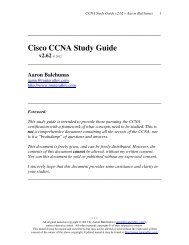Multilayer Switching - Router Alley
Multilayer Switching - Router Alley
Multilayer Switching - Router Alley
You also want an ePaper? Increase the reach of your titles
YUMPU automatically turns print PDFs into web optimized ePapers that Google loves.
<strong>Multilayer</strong> <strong>Switching</strong> Methods<br />
MultiLayer <strong>Switching</strong> v1.11 – Aaron Balchunas<br />
<strong>Multilayer</strong> switches contain both a switching and routing engine. A packet<br />
must first be routed, allowing the switching engine to cache the IP traffic<br />
flow. After this cache is created, subsequent packets destined for that flow<br />
can be switched and not routed, reducing latency.<br />
This concept is often referred to as route once, switch many. Cisco<br />
implemented this type of <strong>Multilayer</strong> switching as NetFlow switching or<br />
route-cache switching.<br />
As is their habit, Cisco replaced NetFlow multilayer switching with a more<br />
advanced method called Cisco Express Forwarding (CEF), to address<br />
some of the disadvantages of route-cache switching:<br />
• CEF is less intensive than Netflow for the multilayer switch CPU.<br />
• CEF does not cache routes, thus there is no danger of having stale<br />
routes in the cache if the routing topology changes.<br />
CEF contains two basic components:<br />
• Layer-3 Engine – Builds the routing table and then routes data<br />
• Layer-3 Forwarding Engine – Switches data based on the FIB.<br />
The Layer-3 Engine builds the routing table using standard methods:<br />
• Static routes.<br />
• Dynamically via a routing protocol (such as RIP or OSPF).<br />
The routing table is then reorganized into a more efficient table called the<br />
Forward Information Base (FIB). The most specific routes are placed at<br />
the top of the FIB. The Layer-3 Forwarding Engine utilizes the FIB to then<br />
switch data in hardware, as opposed to routing it through the Layer-3<br />
Engine’s routing table.<br />
Additionally, CEF maintains an Adjacency Table, containing the hardware<br />
address of the next-hop for each entry in the FIB. Entries in the adjacency<br />
table are populated as new neighboring routers are discovered, using ARP.<br />
This is referred to as gleaning the next-hop hardware address.<br />
Creating an adjacency table eliminates latency from ARP lookups for nexthop<br />
information when data is actually routed/switched.<br />
(Reference: http://www.cisco.com/en/US/docs/ios/12_1/switch/configuration/guide/xcdcef.html)<br />
* * *<br />
All original material copyright © 2009 by Aaron Balchunas (aaron@routeralley.com),<br />
unless otherwise noted. All other material copyright © of their respective owners.<br />
This material may be copied and used freely, but may not be altered or sold without the expressed written<br />
consent of the owner of the above copyright. Updated material may be found at http://www.routeralley.com.<br />
4

















